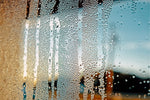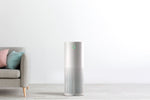Does Heat Kill Mold? Facts and Effective Methods
If you’re considering using heat to tackle mold in your home, it can be an effective solution under the right conditions. While heat can kill mold spores, it requires consistent, high temperatures for a sustained period. Simply turning up your thermostat won’t do the trick—heat must be applied thoroughly to eradicate mold.
However, while heat may kill mold, it won’t remove dead mold spores or the mycotoxins they leave behind, both of which can still pose health risks. This is why it’s important to follow up heat treatment with proper air cleaning using a high-quality air purifier like Jaspr. In this blog, we’ll cover:
• How heat kills mold
• Whether high temperatures eliminate mold entirely
• Challenges of using heat to kill mold
• Why an air purifier is essential after heat treatment
How Does Heat Kill Mold?
Applying sufficient heat can effectively kill mold by drying out the atmosphere and creating conditions where mold can’t survive. Mold typically dies at temperatures between 140°F to 160°F (60°C to 70°C), but for heat treatment to be effective, the temperature must be maintained for a long enough period.
For full effectiveness, areas affected by mold need to be thoroughly assessed to ensure heat is applied evenly across the entire space. This prolonged exposure prevents mold regrowth by completely killing off live mold.
Does Heat Kill Mold on Household Objects?
While heat can kill mold on household objects, it’s not always the best solution. Directly applying heat with blowers or heat guns can risk spreading mold spores to other areas of your home if not done carefully.
To avoid spreading mold spores, proper containment should be used. However, containment barriers like plastic sheets can be tricky since some plastics release harmful chemicals when exposed to high heat. In many cases, alternative methods for mold removal, such as air purifiers, may be more effective.
Does Heat Kill Mold on Food?
We’ve all encountered the disappointment of discovering mold on food. While heat can kill mold on food, it doesn’t necessarily make the food safe to eat. Once mold has grown, it produces mycotoxins, which are harmful substances that remain even after the mold is killed.
Key Points:
• Heat Kills Mold but Not Toxins: Even though heat can kill mold, mycotoxins produced during the mold’s growth remain, making the food unsafe to eat.
• Discard Moldy High-Risk Foods: Foods like cooked meats, soft cheeses, and fruits should be discarded if moldy.
• Safe Consumption of Moldy Hard Foods: In certain hard foods like salami, hard cheese, and root vegetables, you can safely cut away at least an inch around the mold and consume the rest.
Will High Temperatures Completely Eliminate Mold?
Although high temperatures can kill mold, they do not remove it from surfaces. Even after heat treatment, dead mold spores remain on walls, ceilings, and other affected areas. These spores can still release into the air and cause health problems like respiratory issues or allergies.
When mold is killed, it may release spores all at once, which is why heat treatment alone isn’t enough. Mold spores—whether from live or dead mold—are harmful and need to be addressed through air purification to ensure complete safety.
Why an Air Purifier is Essential After Heat Treatment
Once heat kills the mold, dead mold spores still remain in the air, which can pose health risks if not properly removed. This is where an air purifier like Jaspr becomes essential.
Jaspr’s Role in Mold Removal:
• Activated Carbon Filters: Jaspr’s filters trap airborne particles, including mold spores and the mycotoxins responsible for musty odors.
• HEPA Filtration: Jaspr’s HEPA filter captures tiny mold spores that would otherwise remain suspended in the air.
• Advanced Sensors: Jaspr’s real-time air quality sensors detect mold spores and other airborne threats, adjusting its performance to clean the air effectively.
By using Jaspr after heat treatment, you eliminate airborne mold spores that pose health risks and prevent them from spreading further.
Challenges of Using Heat to Kill Mold
If you’re considering using heat to kill mold, be prepared for the following challenges:
1. Inconsistent Heat Distribution
Achieving consistent heat distribution across all affected areas is difficult. If parts of the moldy area don’t receive enough heat, mold can survive and regrow.
2. Risk of Damage to Belongings
Prolonged exposure to high heat can damage furniture, flooring, or other household items. Heat treatment needs to be applied carefully to avoid harming your belongings.
3. Mold Spores Remain in the Air
Even if the mold is killed, spores can still remain airborne. Without proper ventilation or air purification, these spores can spread to other parts of the house, potentially causing new mold growth.
Other Ways to Prevent Mold Growth
While heat can kill mold, it’s essential to take preventive measures to avoid future mold growth. Here are a few ways to help keep mold at bay:
• Ensure Proper Ventilation: Good airflow throughout your home can help prevent moisture buildup, which encourages mold growth.
• Regularly Clean Moist Areas: Bathrooms and kitchens are especially prone to moisture, so regular cleaning and drying of these areas is crucial.
• Use an Air Purifier: After heat treatment, using a high-quality air purifier like Jaspr will ensure any remaining spores are filtered out, reducing the risk of mold returning.
Final Thoughts
While heat can play a role in stopping mold growth, it’s not a complete solution. Dead mold spores and mycotoxins remain in the air, posing health risks even after heat treatment. To fully address the problem, it’s essential to use an air purifier like Jaspr to capture airborne mold spores and improve your home’s air quality.
By combining heat treatment with Jaspr’s advanced filtration system, you can create a safer, mold-free environment in your home.
FAQs
Can heat kill mold completely?
Yes, heat can kill mold spores, but it doesn’t remove them from surfaces or the air. After using heat, an air purifier like Jaspr is essential to capture and remove dead mold spores from your home.
Is it safe to eat moldy food if I heat it?
No, even if heat kills the mold on food, the mycotoxins produced by the mold remain, making the food unsafe to eat.
Should I use an air purifier after heat treatment for mold?
Absolutely! An air purifier like Jaspr, with its HEPA and activated carbon filters, will capture mold spores that remain in the air after heat treatment, ensuring cleaner, safer air.



